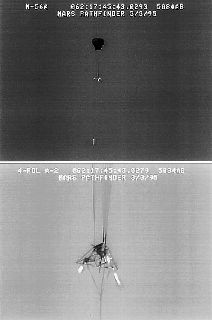
MARS PATHFINDER STATUS
Tony Spear
By this time next year--only 8 months from launch--the Mars Pathfinder project will be just over 3 years old, having completed 19 months of pre-project activities and 18 months of full-scale development in a record inception-to-launch timeframe. The Project is now changing from design activities to subsystem fabrication. Detailed designs are complete for the spacecraft structure, power system, attitude control system, command and data finding system, and most of the entry, descent, and landing hardware. Most fabrication will be completed by June 1995, at which time spacecraft assembly, test, and launch operations (ATLO) will begin.
Initial tests of the retrorocket system were completed successfully in March 1995 at the China Lake Naval Testing Station in California. These tests showed that the retrorocket system was conceptually sound and could provide the required performance on Mars. This testing is required to ensure that Pathfinder is ready for launch.
 Mars Pathfinder Engineering Model Rocket Assisted Descent Drop Test at China Lake, CA.
Mars Pathfinder Engineering Model Rocket Assisted Descent Drop Test at China Lake, CA.
Testing is critical to the success of Pathfinder. ATLO planning is underway to assemble the spacecraft quickly and maximize the amount of test time before launch. The ATLO phase will take about 18 months, more than twice the primary mission duration (7 months of cruise time plus 1 month of surface operations). The flight system will acquire up to 2000 hours of testing, effectively "burning in" the electronics before the launch.
In the Spring of 1996, system-level environmental tests will be performed, including thermal/vacuum, acoustic, and static load tests. The rover will be included in all flight system tests and will also be subjected to surface operations tests in a simulated Mars environment at JPL.
There are also plans for an extensive series of entry, descent, and landing tests. Pioneer Aerospace will test the low-altitude parachute. At the NASA Lewis Research Center's Plum Brook vacuum chamber in Ohio, ILC Dover will test the airbag drop in a simulated Mars atmosphere. And JPL will conduct final tests of the retrorocket system, as well as airbag retraction and lander uprighting.
Mars Global Surveyor Status
Glenn E. Cunningham
The Mars Global Surveyor (MGS) project is finishing up the design of the mission and the spacecraft, and is beginning to build new hardware for the spacecraft and two science instruments.
Project engineers have now specified what path the spacecraft will take on its journey to Mars, the characteristics of the orbit it will fly around the planet, and how NASA's deep space tracking network of antennas will send commands and receive data from the spacecraft. One of the biggest pieces of work is developing the aerobraking techniques that will be used to slow the spacecraft's speed around Mars, lowering the spacecraft's orbit into the desired circular orbit from which to map the surface. A group of experts in the sciences and technologies required for aerobraking has advised the project on this effort (also see the aerobraking model article in this issue).
With less than 2 years until launch, scientists and engineers who will do the imaging science experiments have just completed assembly of the very high resolution camera that will take pictures of the Martian planet surface, and are readying the camera for its environmental tests. Assembly has also started on the Thermal Emission Spectrometer and the Mars Orbital Laser Altimeter, the two inherited instruments from the Mars Observer mission that have to be rebuilt because no spare units existed.
The project's principal industrial partner, Martin Marietta, has just completed building an "engineering development unit" structure assembly. This is a full-size test model of the large box-like honeycomb and composite material structure that houses the electronic heart of the spacecraft and provides the mounting surface for the science instruments. It will be used very soon for a series of special tests that will demonstrate how the spacecraft attaches to the Delta II launch rocket.
Most of the electronic assemblies that regulate the spacecraft's electrical power, control the pointing of the science instruments toward the planet's surface (as well as the solar panels toward the sun and the radio communications antennas toward the Earth), provide communications, and sequence the spacecraft's activities are being upgraded and retested by their manufacturers.
The project has just successfully demonstrated to NASA that plans for building and operating the spacecraft are affordable within the budget that has been approved by Congress, and that there is sufficiently high probability of mission success to continue to work toward launch.
The project is moving ahead rapidly with a very enthusiastic team of people who are working very hard. We even have a new logo! (see article in this issue). While small design and manufacturing problems crop up on an almost daily basis, the ingenuity of the team has been successful in overcoming them, and there are no significant problems in MGS's path at this time.
Return to Cover Page


 Mars Pathfinder Engineering Model Rocket Assisted Descent Drop Test at China Lake, CA.
Mars Pathfinder Engineering Model Rocket Assisted Descent Drop Test at China Lake, CA.